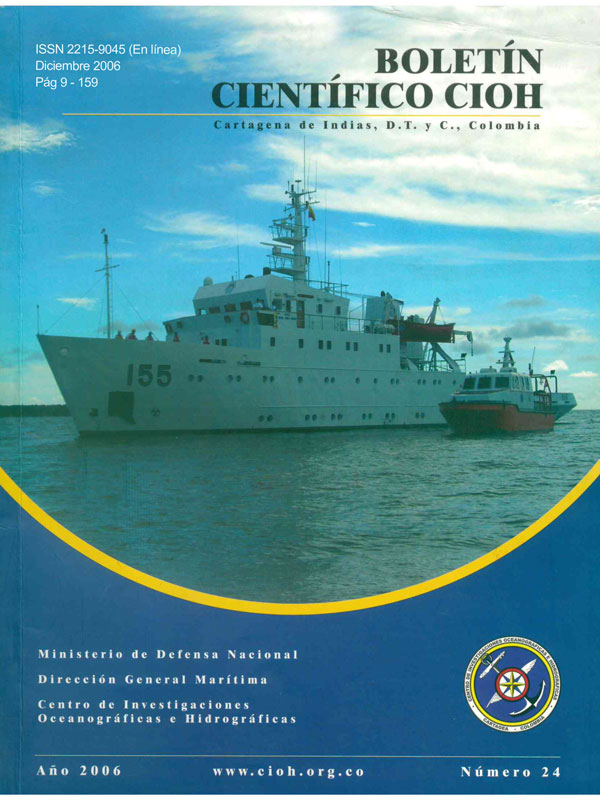Potencial en Colombia para el Aprovechamiento de la Energía No Convencional de los Océanos
DOI:
https://doi.org/10.26640/22159045.145Palabras clave:
Energía No Convencional, Clima de Olas, Boya de Oleaje Direccional, Corrientes de Marea, Gradiente TérmicoResumen
Se evalúan los sitios en la geografía colombiana que debido a sus condiciones oceanográficas, cuentan con mayor potencial para la generación eficiente y económicamente competitiva de electricidad a partir de la energía no convencional contenida en los océanos. Se evalúan las corrientes de marea en Bahía Málaga en el océano Pacífico, encontrando que para explotar este tipo de energía sería necesario realizar unas modificaciones a los canales de acceso para alcanzar la velocidad de corrientes requeridas, los cuales por la magnitud de las obras e impacto negativo en la bahía desestiman esta alternativa. En el Caribe se valora la energía contenida en las olas de viento para la península de la Guajira, encontrando por métodos indirectos un flujo de energía promedio anual de 11.67. Al analizar una serie de tiempo de 28 días colectada con una boya de oleaje direccional en Bocas de Ceniza – Barranquilla, se encontró un flujo promedio de energía de 16.11, la cual supera los niveles mínimos (15) para la generación económica de electricidad. En la Isla de San Andrés se analiza el gradiente térmico del océano, encontrando las condiciones oceanográficas necesarias para aprovechar esta energía con capacidad de satisfacer la demanda de electricidad de la Isla.
Descargas
Referencias
[2] Pulido A. Repsol y el motor del capitalismo global. No.22 de la revista Pueblos. Especial Multinacionales, p. 29-31; 2006.
[3] George R, Norrish Wand Keightley E. The conditions of reaction of hydrogen with sulphur. Part V. Photochemical union, J. Chem. Soc., Trans.125,20702081;1924.
[4] Medina A, Lugo E, y Novelo A. Contenido mineral del tejido foliar de especies de manglar de la Laguna de Sontecomapan.(Veracruz, México) y su relación con la salinidad. E. Biotrópica, Vol. 27, No. 3, p. 317-323; 1995.
[5] Reali M. Submarine hydro-electro-osmotic power plants for an efficient exploitation of salinity gradients Energy (UK), vol. 6, Mar. 1981, p. 227-231; 1981.
[6] Strellec K. Diversifying energy industry risk in the Gulf of Mexico, Coastal Marine Institute, Lousiana State University, on-going research; 2007.
[7] Maser M. Tidal Energy a primer. Vancouver (BC): Blue Energy Canada Inc.; 2004.[citada 2006 jun 20], pl 2. Disponible en: http://www.bluenergy.com/TidalEnergyPrimer.pdf.
[8] Torres R. Informe procedimiento técnico para establecer la línea de más alta marea en la Boquilla Municipio de Cartagena. Documento interno CIOH; 2006.
[9] Otero L. Determinación del régimen medio y extremal del nivel del mar para la Bahía de Buenaventura. Boletín Científico CCCP No. 11: 30-41; 2004.
[10] SWECO, Simulaciones de las Corrientes Bahía Málaga; 1985.
[11] Army Corps of Engineers. The Coastal Engineering Manual; 2001.
[12] Programa de energía por olas de Dinamarca. Disponible en Internet: www.waveenergy.dk/wave_forside/4english/papers/paper_aau00.pdf.
[13] Airy, G. B. Tides and Waves, Encyc. Metrop., Article 192; 1845. pp 241-396.
[14] Comisión Europea. Red temática Europea para la energía por olas. Programa de energía, medio ambiente y desarrollo sostenido. Disponible en Internet: www.wave-energy.net.
[15] Young I. Wind and Wave Climate. Reino Unido. Software; 2000.
[16] Gulev S, y Hasse L. Centro Nacional de Investigación Atmosférica de los Estados Unidos. North Atlantic Wind Waves and Wind Stress. Disponible en Internet: www.dss.ucar.edu/datasets/ds540.1/1998.
[17] Lonin S, Lonina I, y Tuchkovenko Y. Utilización del modelo Nedwam para el cálculo y pronóstico del oleaje en el Mar Caribe. Boletín Científico CIOH No. 17: p. 37-45; 1996.
[18] Natural Energy Laboratory of Hawaii. Disponible en Internet: www.nelha.org/otec.html#otec.
[19] Vega L. Ocean thermal energy conversion. Enciclopedia de energía, tecnología y el medio ambiente. Nueva York: Wiley e Hijos; 2002. p 2104-2119.
[20] Archipielago's Power & Light. 2002. Disponible en Internet: www.apl.com.co/.
[21] Physical Oceanography Distributed Active Archive Center. NASA. Información general. Disponible en Internet: http://podaac.jpl.nasa.gov/info/.
[22] University Corporation for Atmospheric Research. Data Support Section. World Ocean Atlas; 1998. Disponible en Internet: www.dss.ucar.edu/datasets/ds285.0/data/woa98/.
[23] Andrade C. Circulation and Variability of the Colombian Basin in the Caribbean Sea, Ph. D. thesis, p. 223 Univ. of Wales at Menai Bridge, U.K.; 2000.
[24] Torres R. Estudio del potencial en Colombia para el aprovechamiento de la energía No Convencional de los Océanos. Trabajo de Investigación. Disponible biblioteca Escuela Naval Almirante Padilla; 2003.
Descargas
Publicado
Número
Sección
Licencia
Reconocimiento — Debe reconocer adecuadamente la autoría, proporcionar un enlace a la licencia e indicar si se han realizado cambios<. Puede hacerlo de cualquier manera razonable, pero no de una manera que sugiera que tiene el apoyo del licenciador o lo recibe por el uso que hace.
NoComercial — No puede utilizar el material para una finalidad comercial.
SinObraDerivada — Si remezcla, transforma o crea a partir del material, no puede difundir el material modificado.
No hay restricciones adicionales — No puede aplicar términos legales o medidas tecnológicas que legalmente restrinjan realizar aquello que la licencia permite.



